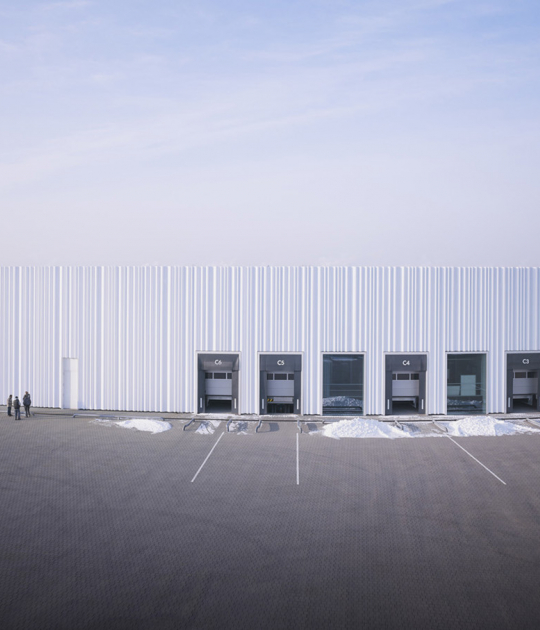The project designed by EOVASTUDIO architects encompasses the different parts of the programme in a single volume made up of a single material, to create a building of a dominant character. The constructed system used, of dry-joint metal cladding, is related to both, the industrial rhetoric and the motor world.
The volumetry is resolved by means of a simple formal operation, with no other mechanisms than the façade planes themselves, inclining them until they reach almost 45º.
For its structure, a hybrid system of beams and poststayed and cable-stayed pillars is used, which reduces the bracing elements to the main porticoes of the building.
Description of project by EOVASTUDIO architects
On the right bank of the mouth of the Rio Tinto, on a plain adjacent to the Nicoba marshes, the largest industrial estate in the province of Huelva extends. On the outskirts of the industrial estate, on a plot of land between the urbanised and the void, the Swedish truck manufacturer Scania decided to locate its new facilities in the region.
The main quality of this location was that of having a direct connection with the different infrastructures that surrounded it, offering the challenge of facing a complete visual exposure, where architecture becomes an advertising element as well as a functional container.
The program requested was simple but with opposite conditions. On the one hand, a large diaphanous, horizontal and zenithally illuminated space for the adjustment of the trucks. On the other hand, a display space and commercial area at various levels with natural light needs for the administrative units.
The requirement to create a building with a dominant character in the environment leads us to encompass the different parts of the programme in a single volume, with a single material, trusting that this decision will help to make up for the shortcomings that a relatively small programme generated for us for this purpose.
In this way, the marked unevenness of the plot is used in favour of these interests, creating a large esplanade in front of the access area, delaying the position of the retaining wall and also superimposing the programme vertically on the head of the building, all in order to increase the height of the volume from 10 metres in the rear areas to almost 20 metres in the main western corner.
This set of volumetric needs are resolved by means of a simple formal operation, an inclination or folding of the façades until reaching almost 45º, in a gesture that begins continuous and symmetrical and then adapts to the specific conditions of each orientation, prolonging and dilating the access thresholds with no other mechanisms than the façade planes themselves.
To this end, it was decided to use a structural system of cable-stayed and post-stayed beams and pillars, a hybrid scheme that stiffens the structure until no more bracing elements were required than the main porticoes of the building. But also with a direct and precise construction system of dry-joint metal cladding, materials belonging to industrial rhetoric but also to the motor world, seeking a natural dialogue with the real users of the building.










































